Interview with founder of TOMS Blake Mycoskie|Making philanthropy fashionable
April 15,2016
American economist Milton Friedman is often quoted as saying, тThe one and only social responsibility of a company is to increase profits.т This concept was popular for the past century, but Blake Mycoskie, a new generation of fashion and lifestyle entrepreneur, believes тIf you integrate philanthropy into your business model, you can have more business opportunities than companies that only care about profit and loss."
In 2006, Blake founded TOMS in order to donate shoes to the children who didnтt have adequate shoes in Argentina. In line with the principle of тone for oneт, with every product customers purchase, TOMS will help a person in need. Blake believes donation could be a habit, instead of an exclusive honour to millionaires. Since shoes are high-margin profit products in the apparel industry, and the cost structure is adjustable according to the market situation of each region, TOMS can afford to make donations without any additional price increases.

For the past decade, the One for OneТЎ model has gradually expanded from "shoes - shoes" to "eyewear - sight restoration", "coffee beans - drinking water", "bags - midwifery bags", etc. TOMS sold products to 55 countries and regions, provided charity services to people in 70 countries and donated 50 million pairs of shoes to help more than 360,000 people restore their sight. The company's annual sales exceeded US$250 million three years ago. In 2014, TOMS announced its partnership with Bain Capital, a leading global private investment firm, and planned to accelerate the growth of the company and its giving programs around the world.
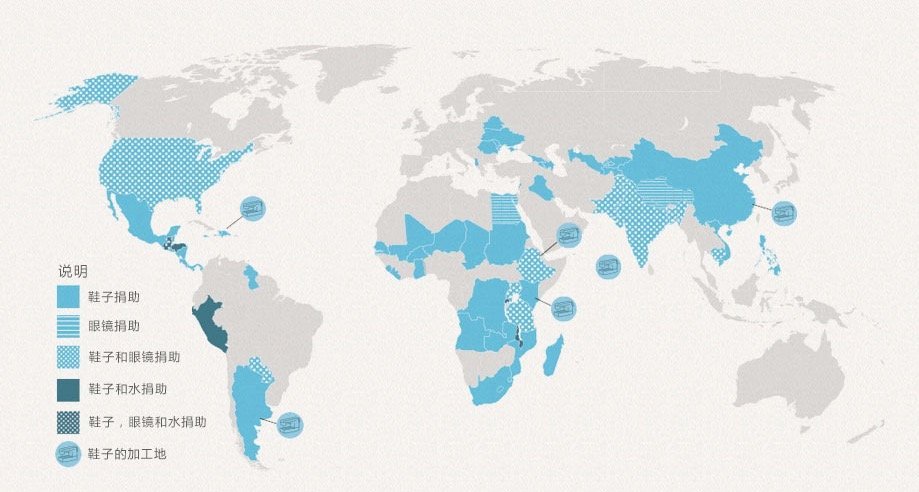
In early April, Blake came to Shanghai to present the charity concept to the younger Chinese consumers. As the earliest media reported TOMS to Chinese readers, Luxe.Co was invited to participate in TOMS's 10th-anniversary party to talk with Blake about his One for OneТЎ model, the company's operation status, and its China market plan.
The birth of TOMS
Denim shirts, floral trousers, and a pair of TOMS lazy shoes, Blake seemed to have nothing to do with the title of "entrepreneur". A typical American born in Arlington, Texas, Blake is however often mistaken for Latin American and even a Spanish-speaking revolutionary leader because of his shoes, social enterprise ideals, and storytelling style.
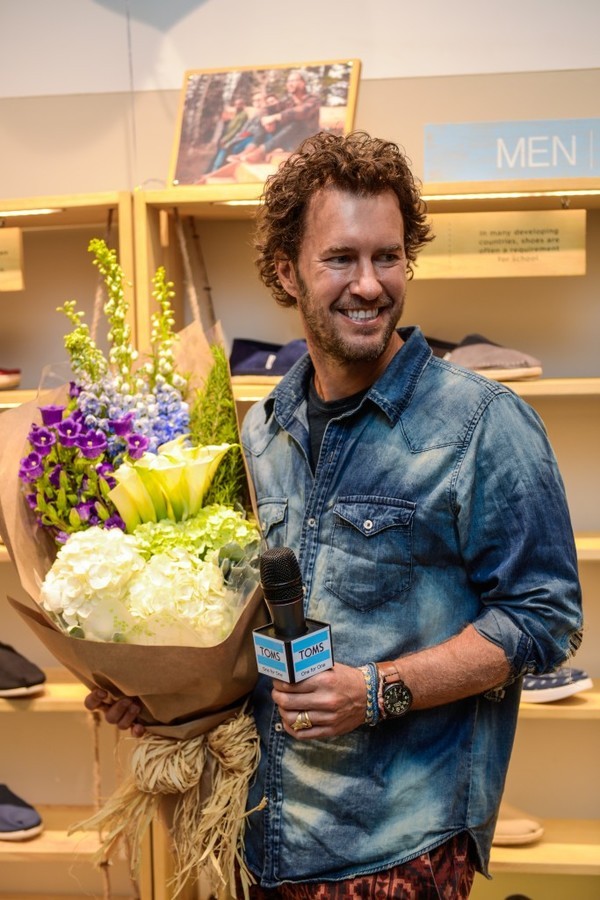
(The logo of TOMS, using the blue and white colour of the Argentine national flag)
Blake got attached to Latin America during the second season of the "The Amazing Race" reality show hosted by CBS in 2002, when he used to run wildly in Argentina. He and his sister Paige Mycoskie won the third place in this global competition, only 4 minutes away to win the $1 million prize. Blake always regarded this a great pity in his life.

яМPaige Mycoskie & Blake MycoskieяМ
In January 2006, 29-year-old Blake traveled to Argentina to study tango and polo. People in Buenos Aires always wore a pair of lightweight canvas shoes. Of course, Black was also one of them with such alpargata.
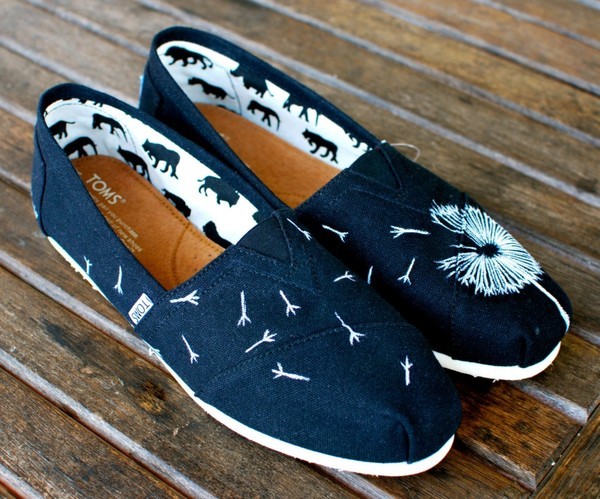
Once, Blake went to a village outside the city with an American woman who donated shoes locally, he saw many children being infected with various diseases with bare feet and missing the opportunity to go to school.
Blake wanted to help them solve the problem. However, traditional footwear charities rely on people's donation. It is difficult for children to obtain stable and fit shoes by occasional charity. As a result, the entrepreneur who started four businesses (college student laundry service, reality show TV channel, social advertising marketing company and teenager online driving course) found a solution from his familiar business field. The new company specialized in alpargata, and each time a pair of shoes is sold, a new pair of shoes is delivered to the children in need.
The new company was named as "Shoes for Tomorrow", then abbreviated as "Tomorrow's Shoes", and eventually called TOMS. Until today, many people still think Mr Mycoskie's name is Tom.
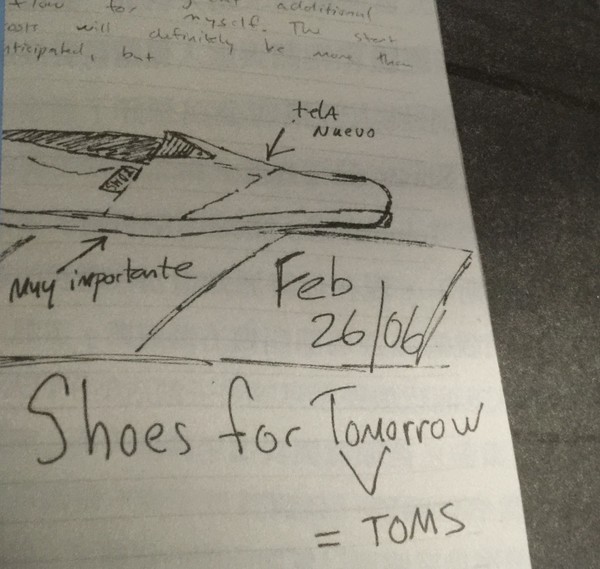
(Shoe sketch and brand name concept was drawn by Blake at the beginning of TOMS)
Blake, together with the equally inexperienced polo coach Alejo partnered together. They persuaded the local shoe factory to produce 250 pairs of alpargata that looked more stylish and Americanized. They brought these MVP (minimum viable products) back to Los Angeles and tested them among friends. The feedback was unexpectedly good. People not only bought those shoes but also recommended several shops that might be interested in helping him sell shoes. The purchasing director of an American Rag shop appreciated TOMS and became its first retail customer.
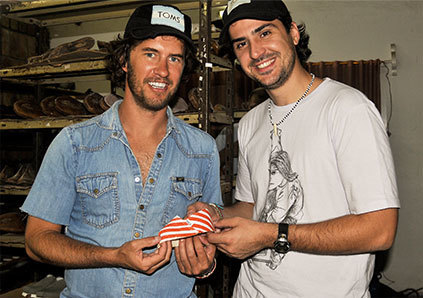
(Blake and partner Alejo in Argentina local shoe factory)
Good news never comes alone. On a Saturday morning. Blake was stunned by the BlackBerry's e-mail alert: the Los Angeles Times fashion columnist put the story of TOMS on the front page, bringing orders for 2,200 pairs of shoes in one day. This was also the first time TOMS faced the challenge of supply chain management: Blake and colleagues spent eight weeks to make shoes in Argentina and sent them to the US.
In the next six months, TOMS was reported by several mainstream publications such as Vogue and Time. Celebrities such as Keira Knightley and Scarlett Johansson were also wearing TOMS. Many people who liked the concept voluntarily shared the story of TOMS to their friends. By the end of the summer, Blake sold 10,000 pairs of shoes and kept his One for OneТЎ promise. He returned to Argentina and donated another 10,000 pairs of shoes to local children. Blake felt an unprecedented sense of fulfilment and decided to sell the shares of the former online driving training company and put all of them into TOMS. He no longer needed to complete his life ambitions separately.
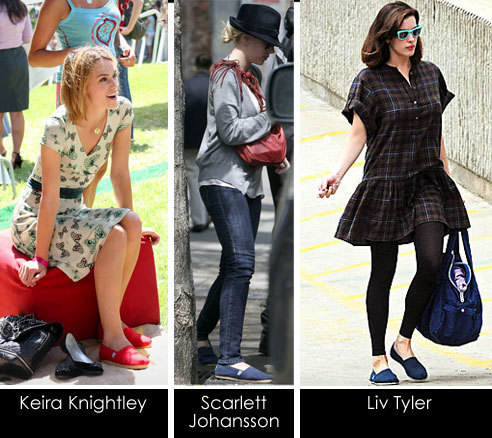
Marketing Strategy
Blake adopted a variety of creative ways to convey the story of TOMS, such as running the Airstream camping trailer to travel around the US, donating shoes in various department stores, filming a documentary to the premiere of the TriBeCa Film Festival in New York, launching "One day without shoes" movement etc.. These ideas were not only created by Blake and his company but also from the supporters. Blake later summed up a major feature of TOMS's One for OneТЎ model: voluntary philanthropy aroused by social media. Now with 5 million social media followers, TOMS could save substantial promotional costs and advertise its products in a more interactive way.
In his book "Start Something that Matters, " Blake listed several ways to spread brand stories:
- Share your story with as many people as possible: make a list of each group that has a relationship with you and can help you spread the story, such as online communities, alumni associations, small groups of interest, etc.
- Find storytelling partners: use cross-over collaborations to expand influence, such as Ralph Lauren's limited-edition x TOMS.
- Find key opinion leaders who like this story, and use their social impact to produce a synergy effect.
- Spread online stories on social networks. In particular, these stories must be real, and in line with the main facts of the story description.
One for OneТЎ, Not Just Shoes
The One for OneТЎ model contradicted with traditional businesses became a success. TOMS's sales increased by 300% by 2011. One-third of the profits came from direct sales by e-commerce. However, due to the scale expansion, TOMS's philanthropy vision and the atmosphere of an equal and efficient startup were gradually eroded. Some early employees left their jobs to go to more entrepreneurial organisations; commercial profits became important. In order to pursue sales targets, TOMS began to discount the products on the website to join the price competition among footwear e-commerce. At the same time, the One for OneТЎ model also bore criticism from the outside: philanthropy cannot touch the roots of poverty, and can even damage the local fair trade, making it impossible for local companies to compete with free donated products.
Blake began to reflect on his business and rethought the original intention of starting TOMS. тThe outside criticism is fair. Education and employment are the keys to alleviating poverty.т Blake realised that in addition to providing shoes directly, TOMS should create more jobs for underdeveloped regions. In 2013, TOMS donated a factory in Haiti, employing more than 100 local people to produce shoes and 30 local artists to provide hand-painted designs. Since then, the production of TOMS gradually expanded from China to six countries in Latin America, Africa, and Southeast Asia. TOMS currently supplies more than one-third of footwear production from these areas, providing more than 700 jobs.
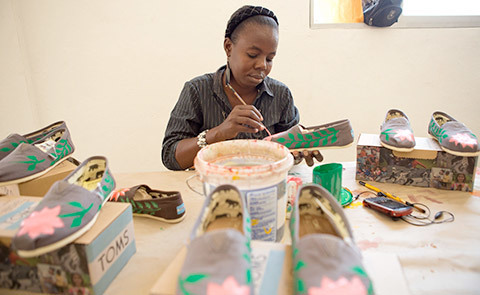
The strategy of One for OneТЎ itself also needed new growth points. Blake learned from a social entrepreneur, Scott Ford, that water is important for the production of coffee beans. Scott's social enterprise, Westrock Coffee, helped Rwanda's coffee growers build community-owned cleaning stations, which increased the market value of coffee beans and prevented water-borne diseases. Scott purchased coffee beans directly from growers and protected them from unfair trade in the midstream of the industry chain.
Almost all places where TOMS provides services lack of clean drinking water. Combing the needs of water and learning from Scott's approach, Blake established a special baking company in 2014. тEvery bag of coffee beans sold will provide a week of clean water for a person in needт. TOMS Bake Company provides financial support to Water For People, a non-profit organisation that builds reservoirs in coffee origins and other areas where drinking water is scarce. Such is TOMS's usual collaboration approach: In addition to the company's dedicated donation team, TOMS has teamed up with more than 100 charities around the world to fulfil its One for OneТЎ commitment.
Starting with the coffee bean-clean water project, Blakes promised to launch a new One for OneТЎ project each year. Finding real and urgent needs and solving them in a commercial way т this is the original intention of Blake's entrepreneurship. Now, the brand has met a new growth point; employees are evoked for their entrepreneurial enthusiasm and mission.
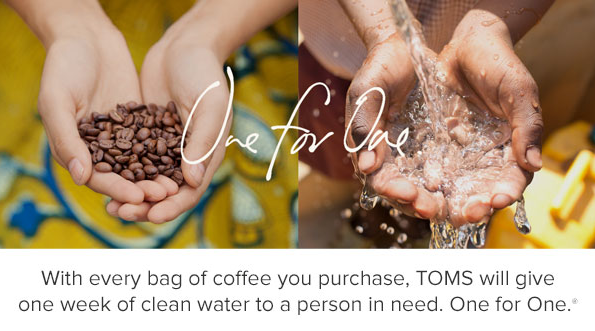
With the increase in donations, TOMS's offline retail stores continue to go beyond imagination. Blake's first store in Venice, California, opened in 2012 provided a demonstration of growth: this is not an ordinary shoe store - you can buy glasses, then coffee beans, and even enjoy yoga classes, movies, and handicraft workshops. TOMS is looking for partners in national markets. The тCoffee + Retailт model will be widely used in global stores. The New York Times commented on TOMS's business model: Mr McCorsky studied Richard Branson's model (After the failure of brand expansion, Branson invested in a joint venture, established a тbrand + creative project + investmentт Virgin Enterprise Cluster). In the future, Blake will open more cafe in Austin, New York, Portland, and other international cities.

The concept of the marketplace has been implemented even earlier online. TOMS Marketplace, a third-party brand market, helps other social entrepreneurs with the same concept to sell their products. At present, more than 30 brands joined, mainly of them are start-ups, but also includes the name such as The Honest Company, an organic household products company"" founded by actress Jessica Alba.
Introduce Capital and Expand Public Welfare
In 2014, Blake made another important decision: looking for investors. On August 20, two months after the issuance of the financing signal, TOMS announced that it would sell 50% of its equity to Bain Capital LLC, a Boston-based a global investment firm. Blake said that his personal and team experience was not sufficient enough to push TOMS's public benefits practice to a broader world. тAfter all, I have never managed such a big business myself,т Blake said earnestly, and he needed assistance from a group with more experience in the global market. Meanwhile, TOMS, which started with online sales, did need funds to support its offline store program.
After talking to 17 funds, Blake and Bain Capital reached an agreement to obtain a 50% shares from TOMS as quickly as possible. Blake believed that Bain could not only help to develop the market, but more importantly, Bain recognised the value and operation of social enterprises, and is "willing to 'protect' TOMS's "giving" business."
Blake remains the remaining 50% of the shares and split the decision-making power with Bain Capital on the board of directors. In the past 18 months, Blake has focused his role on the company's external image, branding, and partnership. Jim Alling, who has worked for Nestle and Starbucks for nearly 20 years, joined TOMS as CEO. Bain Capital strategically guided the company's global development. The two sides also set up a One for OneТЎ special fund to provide incubation and investment to new projects.
In China market, Does One for OneТЎ Work?
TOMS entered China at the end of 2014. It opened more than 30 stores through agency cooperation. The e-commerce team directly sits under the company operated Tmall's flagship store. A total of tens of millions of sales were achieved throughout the year, and a total of 615,000 pairs of shoes were donated in China. After successfully entering the Korean market, Blake regarded China as the most important global market. However, due to different social and cultural characteristics, TOMS also faced some challenges. A Chinese staff member told us at the store that some customers had seen the instructions of One for OneТЎ and curiously asked, тIf I donтt donate another pair of shoes, can I buy these shoes at half price?т In addition, alpargatas are easily copied on e-commerce sites, and their prices are attractive for customers who don't understand the design and brand story behind.
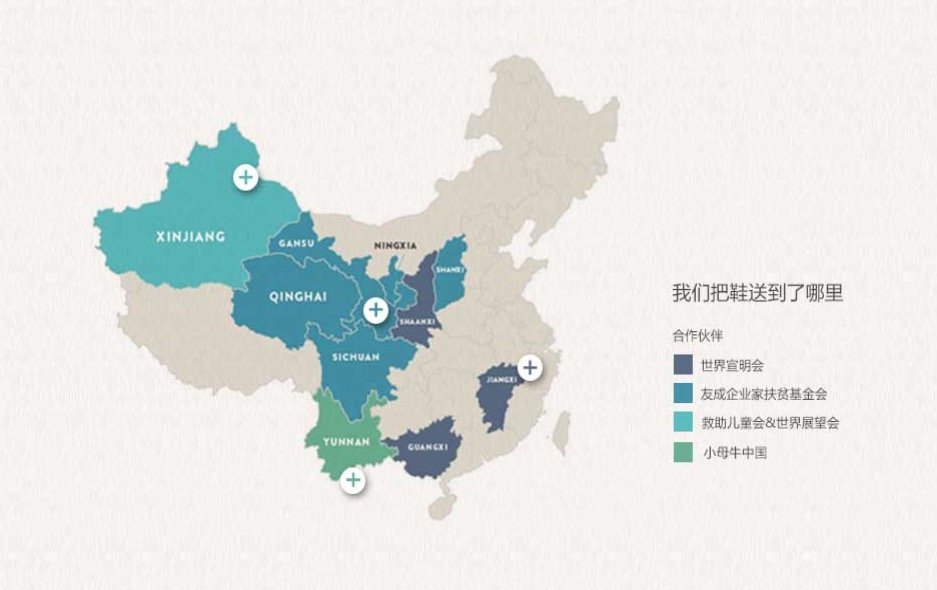
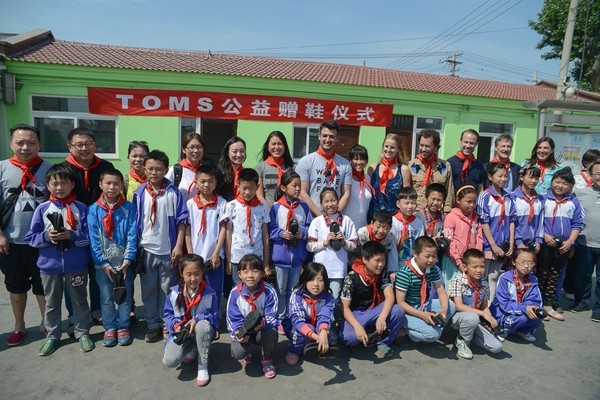


Talking about these situations, Blake expressed his confidence in the China market. The senior generation values more on cost-effectiveness, but the younger generation is the focus. Blake believed, тThey are a global generation who will pay for quality products and public donations, not just for the price."
TOMS also carefully selected several third-party charity partners in China, including World Vision, Youcheng Entrepreneurs Foundation, Save the Children & World Vision, Heifer China (partnership and content as follows). The donation team would supervise the donation of shoes and the use of funds. In response to the needs from different parts of China, TOMS is customising a new One for OneТЎ program involving poverty aids, anti-bullying and anti-child abuse programs.

(Blake with the Luxe.Co team at Shanghai Harbour Plaza)
Attachment: TOMS's ongoing One for OneТЎ project at a glance:
Shoes - Shoes: TOMS not only donate shoes according to different seasons and geographical environment, but also created employment opportunities for these countries. Shoes are distributed to children by non-profit charity organizations around the world. More than 50 million pairs of shoes have been delivered to children in more than 70 countries around the world.
Eyewear - Vision Recovery: For every pair of glasses sold, optical glasses, medical treatment, and corrective surgery are provided for a person in need. Since 2011, TOMS Eye Care has helped 360,000 people regain their vision and boosted the continued development of local eye care programs, creating many professional jobs, especially for young women.
Coffee - Drinking Water: Every time a bag of coffee beans is sold, a week of clean water is provided to a person in need. The International Health Organization recommends that adults drink 20 litres of water a day to maintain their health. TOMS has established seven drinking water systems in the origin places of coffee beans and has provided more than 250,000 weeks of clean drinking water sources.
Bags - midwifery bag: Each package is sold to provide a safe and healthy delivery environment for a woman, including donating a birthing kit or providing safe birth assistance. The kit includes soap, gloves, gauze, umbilical cord clips, surgical blades and more to protect women and newborns from infection.
Backpack - anti-bullying: Every time a backpack is sold, TOMS will donate funds to anti-bullying organizations to support the training of their staff and the implementation of the campus anti-bullying project.
Turtle Series Shoes - Rescue Turtles: For every pair of turtles purchased, TOMS will not only send a pair of shoes to children in need but also donate $5 to the OCEANA Foundation to contribute to saving turtles and protecting the marine ecology.
All data is the latest version at the time of publication. For more information, please visit TOMS official website www.toms.com
Blake Mycoskie with the reporter of Luxe.Co
Edited by: Hanyu Yang












Comments